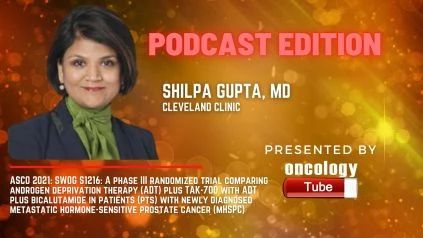Shilpa Gupta, MD from the Cleveland Clinic speaks about the ASCO 2021 Abstract – SWOG S1216: A phase III randomized trial comparing androgen deprivation therapy (ADT) plus TAK-700 with ADT plus bicalutamide in patients (pts) with newly diagnosed metastatic hormone-sensitive prostate cancer (mHSPC) (NCT01809691).
Link to Abstract:
https://meetinglibrary.asco.org/record/196407/abstract
Background information:
Tak is a nonsteroidal 17, 20-lyase inhibitor that inhibits the production of androgens in the gonadal and adrenal glands. In patients with newly diagnosed mHSPC, we looked at the therapeutic benefit of Tak combined with ADT.
Methodologies:
Patients with mHSPC who had a Zubrod performance status (PS) of 0-2 and a PSA of less than 2 ng/ml were randomly assigned to either ADT+Tak (300 mg twice daily) or ADT+Bic (300 mg twice daily) (50 mg daily). PS (0-1 vs 2), illness severity (limited vs substantial), and ADT use previous to enrollment were all used to stratify participants (yes vs no). Overall survival was the major goal (OS). PSA at 7 months (0.2 versus 0.2 PSA; -4 vs. > 4 ng/ml) and adverse event (AE) profile were secondary objectives. We would have 90 percent power to determine a 33 percent improvement in OS from 54 to 72 months with 2.75 years to collect 1,186 eligible points and 3 more years of follow-up (1-sided = 0.025). After 523 fatalities, a final analysis was pre-specified using a 1-sided = 0.022 to account for intermediate studies.
The following are the outcomes:
A total of 1,313 patients were randomized between March 2013 and July 2017, with 1,279 being included in the intention-to-treat (ITT) analysis (32 pts were ineligible and 2 pts withdrew consent). The average age of the participants was 68, and 10% of them were African-American. The median PSA level was 30 ng/mL (range 2-6710), and 49% of patients had advanced illness. PFS and PSA response were considerably better with Tak vs Bic after a median follow-up of 4.9 years, but there was no significant change in OS (Table). Hypertension (20% vs. 5% ) and weariness were the most common grade 3/4 AEs in the Tak vs. Bic arms (43 percent vs. 14 percent ). (5 percent vs. 2 percent ). Grade 5 AE was found at five points in the Tak arm and one point in the Bic arm.
Final Thoughts:
Despite clinically substantial improvements in different outcome indicators when Tak+ADT was used instead of Bic+ADT in this representative sample with mHSPC, the improvement in OS did not meet the pre-specified statistical significance requirements. The control arm’s median OS of 70 months (standard ADT) was greater than that reported in recent phase 3 studies in this scenario, and 16 months longer than previously expected. When patients with mHSPC have access to multiple authorized life-prolonging medicines, this experiment establishes a new standard for survival projections. U10CA180888, U10CA180819, U10CA180820; U10CA180821; and in part by Millennium Pharmaceuticals, Inc. NIH/NCI/NCTN grants U10CA180888, U10CA180819, U10CA180820; U10CA180821; and in part by Millennium Pharmaceuticals, Inc. (Takeda Pharmaceutical Company LTD)
Clinical trial information:
http://clinicaltrials.gov/show/NCT01809691

